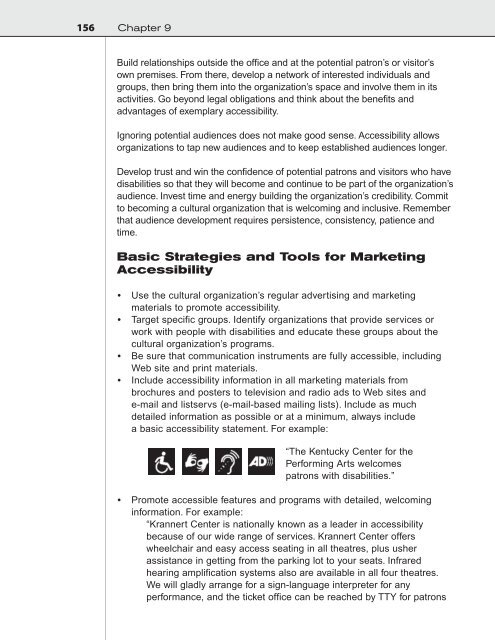Design for Accessibility: A Cultural Administrator's Handbook
Design for Accessibility: A Cultural Administrator's Handbook
Design for Accessibility: A Cultural Administrator's Handbook
Create successful ePaper yourself
Turn your PDF publications into a flip-book with our unique Google optimized e-Paper software.
156 Chapter 9<br />
Build relationships outside the office and at the potential patron’s or visitor’s<br />
own premises. From there, develop a network of interested individuals and<br />
groups, then bring them into the organization’s space and involve them in its<br />
activities. Go beyond legal obligations and think about the benefits and<br />
advantages of exemplary accessibility.<br />
Ignoring potential audiences does not make good sense. <strong>Accessibility</strong> allows<br />
organizations to tap new audiences and to keep established audiences longer.<br />
Develop trust and win the confidence of potential patrons and visitors who have<br />
disabilities so that they will become and continue to be part of the organization’s<br />
audience. Invest time and energy building the organization’s credibility. Commit<br />
to becoming a cultural organization that is welcoming and inclusive. Remember<br />
that audience development requires persistence, consistency, patience and<br />
time.<br />
Basic Strategies and Tools <strong>for</strong> Marketing<br />
<strong>Accessibility</strong><br />
• Use the cultural organization’s regular advertising and marketing<br />
materials to promote accessibility.<br />
• Target specific groups. Identify organizations that provide services or<br />
work with people with disabilities and educate these groups about the<br />
cultural organization’s programs.<br />
• Be sure that communication instruments are fully accessible, including<br />
Web site and print materials.<br />
• Include accessibility in<strong>for</strong>mation in all marketing materials from<br />
brochures and posters to television and radio ads to Web sites and<br />
e-mail and listservs (e-mail-based mailing lists). Include as much<br />
detailed in<strong>for</strong>mation as possible or at a minimum, always include<br />
a basic accessibility statement. For example:<br />
“The Kentucky Center <strong>for</strong> the<br />
Per<strong>for</strong>ming Arts welcomes<br />
patrons with disabilities.”<br />
• Promote accessible features and programs with detailed, welcoming<br />
in<strong>for</strong>mation. For example:<br />
“Krannert Center is nationally known as a leader in accessibility<br />
because of our wide range of services. Krannert Center offers<br />
wheelchair and easy access seating in all theatres, plus usher<br />
assistance in getting from the parking lot to your seats. Infrared<br />
hearing amplification systems also are available in all four theatres.<br />
We will gladly arrange <strong>for</strong> a sign-language interpreter <strong>for</strong> any<br />
per<strong>for</strong>mance, and the ticket office can be reached by TTY <strong>for</strong> patrons


